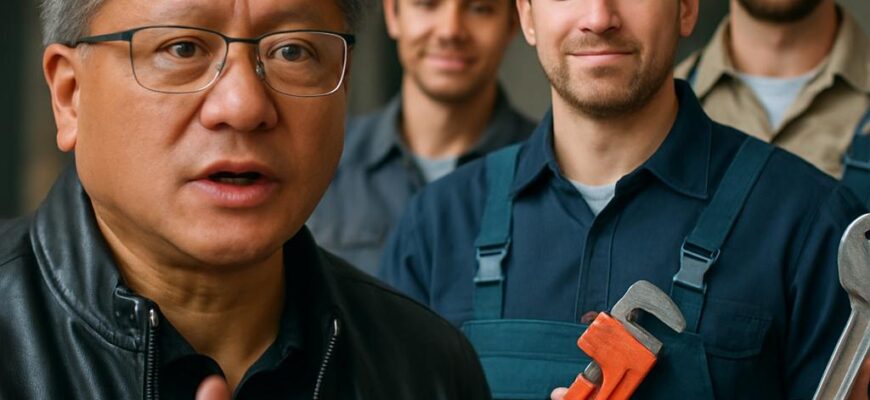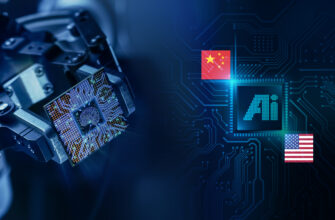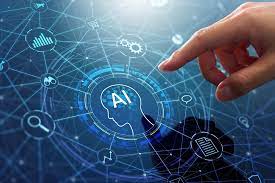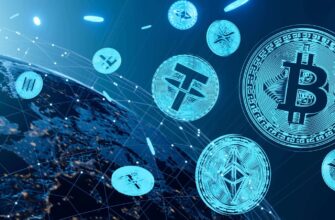When the Nvidia CEO warned that demand for electricians, plumbers, and other skilled trades will grow in “every” country due to the development of neural networks, he pointed to a consequence of AI few people have considered carefully: advanced computing doesn’t live in a vacuum. It needs power, cooling, installation, retrofitting, and on-the-ground maintenance. That creates material jobs and steady demand for practical skills across the built environment.
- From silicon to sockets: how neural networks translate into hands-on work
- Why the demand is global, not just concentrated in tech hubs
- Which trades will see the biggest changes
- Concrete examples: where skill meets silicon
- Infrastructure components and the trades that service them
- Supply chains and the ripple effects on trades
- Training and certification: turning generalist tradespeople into AI-era specialists
- How workers can prepare: practical steps and skills to prioritize
- Business opportunities for small contractors and entrepreneurs
- Policy levers: what governments can do to support the transition
- Equity and access: making sure the benefits reach local communities
- Safety, regulation, and standards in an AI-infused built environment
- Economic effects: wages, labor markets, and the cost of AI deployments
- Geopolitical considerations: national security and local skills
- How automation and AI tools affect trade work itself
- Real-world case studies: what early adopters are doing
- My observations from the field
- Education reform: reshaping curricula for the AI era
- Financing and incentives to grow the trades workforce
- Long-term career pathways in an AI-driven economy
- Risks: what could go wrong if we ignore workforce needs
- How industry and education can collaborate effectively
- Local planning: integrating AI projects into community development
- Career narratives: tradespeople finding new purpose in AI infrastructure
- Practical checklist for policymakers, educators, and contractors
- Global coordination and knowledge sharing
- Measuring success: metrics that matter
- Looking ahead: durable demand, evolving skills
- A final thought on opportunity and responsibility
From silicon to sockets: how neural networks translate into hands-on work
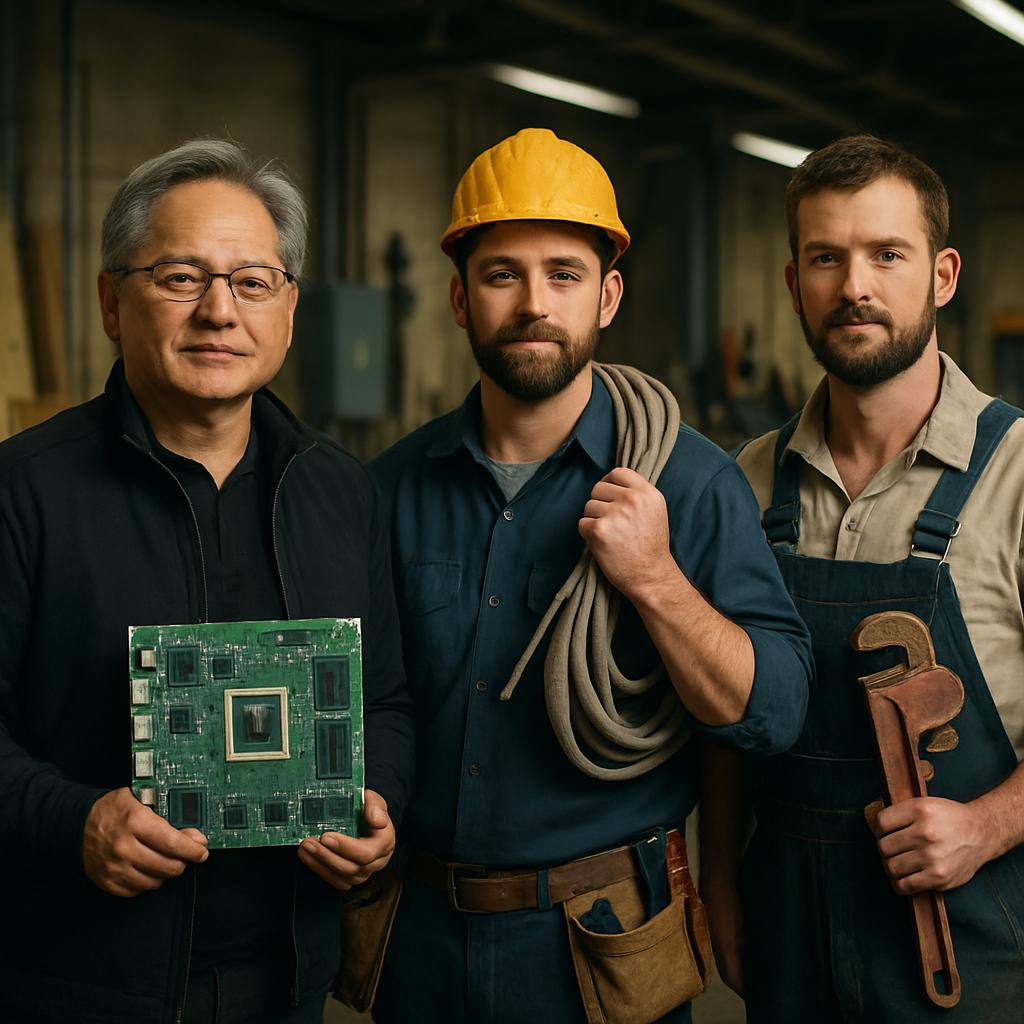
Neural networks run on physical infrastructure: racks of GPUs, power distribution systems, liquid cooling loops, and dedicated buildings. These components require electricians to upgrade power lines, technicians to manage cooling systems, and installers to build and maintain server rooms.
Beyond the server farms, AI pushes computation to the edge—smart factories, hospitals, retail spaces, and connected homes—creating a need for technicians who can wire, mount, and service devices. Every time an AI application moves out of the cloud and into a real-world setting, it creates a chain of practical tasks for skilled tradespeople.
This isn’t hypothetical. When a hospital installs AI-enabled diagnostic machines or when a municipality deploys smart-traffic sensors, those devices must be physically connected, secured, and integrated with local systems. That integration work is done by electricians, network technicians, and often plumbers or HVAC specialists when water or temperature control is involved.
Why the demand is global, not just concentrated in tech hubs
One reason the Nvidia CEO framed the change as happening in “every” country is simple: digital infrastructure is expanding everywhere. Governments and companies across continents are investing in AI-capable systems to improve services, manufacturing, and governance. Those systems need local hands for installation and upkeep.
Developing countries are no exception. Many are leapfrogging legacy systems, investing in data centers, fiber networks, and renewable energy to support digital services. Those projects may rely on international capital and expertise at first, but long-term operation depends on local contractors and tradespeople.
Even rural areas will feel the effects. Edge computing nodes, distributed sensors, and electrified transportation require on-site maintenance. Local electricians and tradespeople become indispensable when systems fail at night or when weather damages infrastructure—conditions that centralized remote teams cannot quickly remedy.
Which trades will see the biggest changes
Electricians are the most obvious beneficiaries. Modern AI equipment draws significant, constant power and often requires three-phase feeds, redundant supplies, and precise monitoring. That means rewiring, substation work, and ongoing electrical maintenance.
Plumbers and pipefitters will see increased demand through their role in cooling and climate-control systems. High-performance computing increasingly uses liquid cooling, and data center water systems or chiller plants call for skilled plumbing, piping, and corrosion management.
HVAC technicians, refrigeration mechanics, fiber-optic technicians, and heavy equipment operators all play roles. HVAC workers manage airflow and environmental control in compute rooms, fiber technicians install high-bandwidth connections, and heavy machinery crews move and install server cabinets and chillers.
Concrete examples: where skill meets silicon

Consider an urban hospital adopting AI for radiology. Radiology suites need upgraded electrical panels, uninterrupted power supplies, and dedicated cooling for the new machines. Electricians and HVAC technicians are called in to handle those upgrades and to coordinate with biomedical engineers for safety compliance.
In manufacturing, a plant that deploys AI-driven quality-control cameras and edge processors will require mounting points, conduit runs, and network cabling throughout the production floor. That work falls to carpenters, electricians, and low-voltage specialists who can integrate those systems without disrupting operations.
Even the rollout of AI in agriculture creates trade work. Autonomous tractors and sensor networks need charging stations, weatherproof cabinets, and fiber or wireless backhauls—tasks for solar installers, electricians, and civil crews to prepare fields and infrastructure.
Infrastructure components and the trades that service them
To make the discussion concrete, here’s a compact view of common AI infrastructure elements and the trades most often involved in their deployment and maintenance. This table highlights how many different hands touch a single AI rollout.
| Component | Trades involved | Typical tasks |
|---|---|---|
| Data center racks and servers | Electricians, riggers, HVAC techs | Power distribution, equipment placement, cooling integration |
| Liquid cooling systems | Plumbers/pipefitters, maintenance techs | Pipe installation, leak detection, pump servicing |
| Edge devices and sensors | Low-voltage techs, fiber installers, electricians | Cable runs, mounting, power and network hookups |
| Renewable energy and storage | Solar installers, battery technicians, electricians | Panel installation, battery integration, grid tie-ins |
Supply chains and the ripple effects on trades
AI hardware alone creates a ripple effect: factories producing servers need welders, machinists, and assembly-line electricians. Logistics hubs that move equipment call on truck drivers and heavy-equipment operators. Local contractors that build data centers employ general laborers, carpenters, and finish tradespeople.
This web of needs means that when AI investment ramps up in a region, it doesn’t just create jobs directly tied to servers—it supports construction, utilities, and services across the supply chain. Small businesses that offer installation and maintenance services often benefit first and most tangibly.
The more localized the infrastructure, the more pronounced the effect. Building micro-data centers or edge nodes in towns rather than centralizing everything in mega-facilities spreads job creation into areas that may not otherwise see such investment.
Training and certification: turning generalist tradespeople into AI-era specialists
Traditional apprenticeship models remain essential, but they must adapt. Electricians and HVAC technicians who understand data center standards, redundancy planning, and liquid-cooling safety will be in higher demand. That requires focused modules in vocational programs and on-the-job certifications.
Many tradespeople can upskill without leaving their trades entirely. For example, a plumber with training in corrosion-resistant piping and water-treatment systems is immediately valuable to data centers using water-based cooling. Similarly, an electrician who learns about power quality, monitoring, and server rack codes becomes a specialist rather than a generalist.
Community colleges, trade schools, and industry associations have roles to play in developing short, targeted courses. Employers can also invest in apprenticeships that include AI-infrastructure-specific competencies, creating a pipeline of workers ready for the next wave of deployments.
How workers can prepare: practical steps and skills to prioritize
For tradespeople deciding how to adapt, three priorities should guide choices: safety and standards knowledge, familiarity with digital monitoring systems, and cross-discipline competence. Those areas will make a worker indispensable on AI-related projects.
Learning to read electrical schematics for three-phase systems, understanding the basics of liquid-cooling plumbing, and becoming comfortable with remote monitoring dashboards are high-return investments. Simple certifications in lockout/tagout, electrical safety, and fiber handling make a candidate more hireable for mission-critical work.
Network with local contractors involved in technology projects and volunteer for small AI-adjacent jobs to gain experience. Many contractors hire helpers for initial installs; those roles are low-barrier ways to get on projects and build a portfolio of AI-related work.
Business opportunities for small contractors and entrepreneurs
Smaller firms often have advantages in agility and local presence when AI projects arrive. A neighborhood contractor can respond faster than a national firm and build long-term relationships with organizations that need ongoing maintenance. That positions small businesses to capture steady, recurring revenue streams.
Specialization can be profitable: offering certified liquid-cooling maintenance packages, emergency power services, or fiber-installation contracts creates differentiated offerings. Entrepreneurs should consider niche services—battery maintenance for charging infrastructure, or environmental monitoring for edge sites—that become essential as AI systems proliferate.
Forming partnerships with local vocational schools to recruit apprentices also gives small firms a labor pipeline and helps them scale when contracts increase. In regions where skilled labor is scarce, firms that invest in training have a competitive edge.
Policy levers: what governments can do to support the transition
Public policy can ease the strain of rapidly growing demand for tradespeople. Targeted funding for vocational training, tax incentives for businesses that hire apprentices, and streamlined permitting for data centers and related infrastructure help match supply with demand.
Local governments should also consider credential portability—recognizing certifications across jurisdictions reduces barriers for workers to move where demand exists. Simplifying inspection and permitting processes for AI infrastructure projects can speed deployments while maintaining safety standards.
Finally, public-private partnerships that fund community training programs tied to real projects create immediate career pathways. When a city plans smart-infrastructure upgrades, tying workforce development to the project ensures local residents benefit from the jobs created.
Equity and access: making sure the benefits reach local communities
AI infrastructure can lift regional economies, but benefits won’t distribute themselves evenly. Without intentional planning, projects can import labor or favor contractors who already have experience, leaving local workers behind. Equity-minded workforce programs are necessary to avoid that outcome.
Programs that subsidize apprenticeships for underrepresented groups, offer childcare during training hours, or provide transportation stipends increase participation. Community engagement early in project planning helps ensure that hiring pipelines and training align with local needs.
When local tradespeople are hired, they bring money back into the community—rent, groceries, and small-business spending—which multiplies the impact. Thoughtful policy design can help communities capture these ripple effects rather than watching them flow outward.
Safety, regulation, and standards in an AI-infused built environment
AI infrastructure introduces specialized hazards: high-voltage power systems, pressurized cooling loops, and heavy, dense equipment that changes fire patterns. All of these require careful adherence to safety standards and sometimes new regulations tailored to emerging technologies.
Trade unions, industry bodies, and regulators must collaborate to set standards for things like coolant handling, fire suppression in server rooms, and emergency power testing. Clear codes and inspection regimes reduce accidents and help insurers underwrite projects predictably.
Training that covers these safety dimensions—hazard recognition, emergency response for liquid-cooling leaks, and safe handling of battery systems—should be mandatory for technicians working on AI infrastructure. That protects workers and the investments they support.
Economic effects: wages, labor markets, and the cost of AI deployments
When trades become scarce, wages rise. Regions that experience sudden bursts of AI-related construction may face higher labor costs and longer project timelines if skilled trades are not available locally. That can push project planners to budget for higher labor rates or to contract internationally for certain tasks.
In the medium term, however, the steady operational needs of AI infrastructure—routine maintenance, emergency repairs, and upgrades—create stable employment. Those ongoing roles can absorb entry-level workers and provide career ladders to more advanced specialties.
For companies deploying AI, factoring the cost of skilled trades into total cost of ownership is essential. Projects that look inexpensive based on hardware alone can become much costlier when you include necessary electrical upgrades, cooling infrastructure, and local compliance requirements.
Geopolitical considerations: national security and local skills
AI infrastructure has national-security implications. Countries prioritizing domestic skills reduce reliance on foreign technicians during crises or supply-chain disruptions. That reasoning drives some government investments in local workforce development for critical infrastructure.
Training a domestic pool of tradespeople also protects sensitive installations and proprietary systems where security clearances or trust level matters. Local personnel with appropriate vetting can be preferable for critical systems in defense, healthcare, or financial services.
On the other hand, global collaboration remains important. Cross-border knowledge transfer—through certification reciprocity, shared curricula, and industry consortia—helps raise standards and accelerates workforce readiness worldwide.
How automation and AI tools affect trade work itself
It’s easy to assume that the same AI driving these infrastructure needs will also replace tradespeople. The reality is more nuanced: AI and automation change the nature of trade work rather than eliminating it wholesale. Robots can assist with inspections, but they do not yet replace the skilled judgment and manual dexterity needed for complex installations and emergency repairs.
Technicians who adopt AI tools—using predictive maintenance dashboards, remote diagnostic systems, or augmented-reality guidance—become more efficient and valuable. Those who ignore these tools risk being bypassed for work that requires data fluency as well as hands-on skill.
Automation may reduce some repetitive tasks, but it raises demand for higher-skill tasks: complex troubleshooting, system integration, and oversight of autonomous maintenance equipment. Those are exactly the roles that pay better and offer career growth to tradespeople who adapt.
Real-world case studies: what early adopters are doing
In industrial settings, some factories that added AI-driven vision systems found themselves hiring additional electricians and cabinetmakers to create secure housings and reliable power feeds for edge hardware. Those are small, concrete examples of how AI installations translate into physical jobs.
Municipal smart-lighting programs that incorporate AI for traffic management often contract local electricians and fiber technicians to retrofit poles, run conduit, and install sensors. These projects typically create steady maintenance contracts that sustain local firms for years after the initial deployment.
In regions with growing data-center clusters, building trades—concrete workers, crane operators, and pipefitters—see higher demand. Those clusters often spur secondary businesses like catering, lodging for transient workers, and supply-chain firms, expanding the economic footprint beyond the tech sector.
My observations from the field
As a writer who has visited server farms and interviewed construction crews, I’ve watched how a single project can ripple through a local economy. I remember one regional data-center expansion where the lead electrician took the time to mentor three apprentices, creating permanent roles that outlasted the construction phase.
On another visit to a manufacturing plant upgrading with AI-enabled inspection systems, the plant manager told me the most valuable hires were electricians who could also understand network diagrams. That combination of practical skill and basic digital literacy made those tradespeople indispensable.
Those firsthand experiences underline a pattern: projects that intentionally integrate local trades and invest in training tend to run smoother and produce more durable community benefits than those that import all labor and expertise.
Education reform: reshaping curricula for the AI era
Vocational curricula need updating to include modules on power electronics, thermal management for computing equipment, and basics of digital diagnostics. Schools that move quickly to incorporate these subjects will produce graduates who can step into AI-related roles immediately.
Short, stackable credentials—micro-certifications that pile up toward more advanced qualifications—are a practical way to keep education nimble. A three-month module on data-center electrical standards, for example, can make a recent apprentice more marketable without derailing their career progression.
Industry partnerships with training providers can ensure courses match on-the-ground needs. Companies can donate hardware for labs, offer internships, and provide instructors with real-world experience to keep classroom training relevant.
Financing and incentives to grow the trades workforce
Policymakers can use tax credits, grants, and loan-forgiveness programs to encourage training in high-demand trades. Financial incentives to employers who hire apprentices or sponsor certification programs can offset the short-term costs of developing talent.
Another effective approach is targeted scholarships for students entering trades linked to critical infrastructure—electrical, plumbing, HVAC—that support AI deployments. These programs expand the pool of candidates and lower barriers to entry for people from underrepresented backgrounds.
Public procurement rules that prioritize local hiring in AI infrastructure projects also direct investment into communities and create predictable demand for training programs. When governments set those expectations, the market responds with education and recruitment efforts.
Long-term career pathways in an AI-driven economy
Skilled trades will offer increasingly diverse career trajectories. A worker starting as an apprentice electrician might specialize in data-center power systems, move into project management, and eventually run their own firm delivering AI infrastructure services. Those are real, upwardly mobile careers.
Tradespeople can also branch into hybrid roles—combining fieldwork with systems analysis, contract negotiation, or business development. The intersection of practical skills and digital know-how opens managerial and entrepreneurial opportunities that didn’t exist a decade ago.
As AI systems age, retrofitting and upgrading will create sustained demand, giving tradespeople long-term roles that include scheduled overhauls and lifecycle management, not just one-off installations.
Risks: what could go wrong if we ignore workforce needs
If investment in training and local hiring lags behind infrastructure growth, projects will face delays, higher costs, and quality problems. Shortages of qualified tradespeople can drive up wages and encourage corners to be cut—leading to safety risks and unreliable systems.
Dependence on imported labor may solve immediate capacity problems but leaves regions vulnerable to geopolitical tensions and supply-chain disruptions. Relying solely on external technicians also deprives local economies of the multiplier effects that stable, locally hired labor generates.
Finally, if tradespeople are not included in planning, AI deployments may suffer from mismatched specifications, incompatible retrofits, and maintainability issues that shorten system lifespans and increase total costs.
How industry and education can collaborate effectively
Successful collaborations start with shared goals and measurable outcomes. Industry should define the competencies they need and partner with schools to build curricula, internships, and hands-on labs that reflect those needs. That reduces hiring friction when projects commence.
Apprenticeship programs co-designed with employers provide predictable training pipelines and ensure that graduates have both the theoretical knowledge and the practical experience required on day one. These programs also create relationships that make apprentices likely hires after graduation.
Industry can support schools by donating equipment, sponsoring instructors, and offering field placements on real projects. Those investments not only help students but also reduce onboarding costs for employers because graduates are already familiar with workplace expectations.
Local planning: integrating AI projects into community development
When municipal planners evaluate AI-related projects, they should ask how to maximize local employment and training opportunities. Zoning, planning approvals, and community benefit agreements can be structured to require or incentivize local hiring and apprentice use.
Early engagement with local trade councils and vocational providers ensures that projects include realistic timelines for recruitment and training. That prevents last-minute scrambles to find labor and helps keep projects on budget and on schedule.
Transparent workforce plans tied to public approvals create accountability. Communities that demand clear hiring targets and training commitments from developers are likelier to see long-term benefits from AI investments.
Career narratives: tradespeople finding new purpose in AI infrastructure
I’ve spoken with electricians who started their careers in residential work and found new purpose and better pay in commercial data-center projects. They described the work as technical, precise, and satisfying—hands-on troubleshooting with visible, mission-critical results.
Plumbers who transition into liquid-cooling maintenance report similar experiences: the work is more specialized, requires careful documentation, and often comes with long-term service contracts that provide income stability. Those narratives point to a future in which tradespeople manage high-tech ecosystems rather than only fixing leaky faucets or replacing switches.
These career shifts also change perceptions of trade professions. Young people seeing well-paid, stable, and technical career paths in the trades are more likely to consider apprenticeships as a serious alternative to traditional college routes.
Practical checklist for policymakers, educators, and contractors
Here’s a short checklist that stakeholders can use to align efforts and capture the opportunities created by AI infrastructure growth.
- Assess current and projected demand for trades linked to AI projects in your region.
- Create targeted training modules for electrical, plumbing, HVAC, and fiber work related to AI infrastructure.
- Incentivize apprenticeships and provide subsidies for firms that hire local trainees.
- Establish clear safety and maintenance standards specific to AI-related installations.
- Prioritize local hiring in public and regulated projects to maximize community impact.
Global coordination and knowledge sharing
Industry associations and international bodies can accelerate the diffusion of best practices by publishing standards, hosting training exchanges, and facilitating credential recognition across borders. That helps nations with nascent AI infrastructure initiatives avoid predictable mistakes.
Shared toolkits for community engagement, templates for workforce agreements, and publicly accessible curricula reduce duplication of effort and allow regions to learn from early adopters. In the long run, coordinated approaches improve safety and reduce costs globally.
Cross-border apprenticeships and exchange programs also spread skills and create career ladders for tradespeople willing to work internationally. Those programs can help address acute local shortages while building global competence networks.
Measuring success: metrics that matter
When assessing whether AI deployments are delivering local economic benefits, measure outcomes beyond completed projects. Track number of local hires, apprenticeships created, certifications awarded, and long-term maintenance contracts that remain with local firms.
Additional metrics such as average wages for tradespeople on AI projects and the share of procurement dollars spent locally capture economic impact. These indicators help policymakers and industry partners adjust programs to maximize benefits for communities.
Transparent reporting on these metrics builds trust and enables continuous improvement in workforce development and project planning.
Looking ahead: durable demand, evolving skills
As neural networks become more embedded across industries, the demand for skilled trades will be durable rather than fleeting. Hardware needs ongoing care—updates, replacements, retrofits—that translate into persistent career opportunities for tradespeople who adapt.
Skills will evolve: manual expertise remains central, but digital literacy becomes equally important. The trades of the future will be hybrids: part craftsman, part technician, part systems analyst. That combination creates resilient careers that can weather technological change.
For workers, communities, and policymakers, the message is pragmatic: invest in training, update standards, and create clear hiring pathways. The physical systems that power AI will be with us for decades, and the people who build and maintain them will be indispensable.
A final thought on opportunity and responsibility
Nvidia’s observation—that skilled trades will be in higher demand as neural networks spread—is less prophecy than a call to action. The transition can lift wages, create stable careers, and strengthen local economies if stakeholders plan for workforce development now.
That planning requires collaboration across industry, government, and education, and it requires recognizing tradespeople as central contributors to the digital economy. When we prepare workers and communities thoughtfully, the coming wave of AI infrastructure becomes an engine for broad-based economic opportunity rather than a source of exclusion.
There is a real chance to shape this moment so that wiring racks and routing pipes are seen not as backroom tasks but as essential, respected work that powers the systems shaping our future. The practical, skilled hands that install, repair, and optimize the physical foundations of neural networks will be the backbone of that future.

